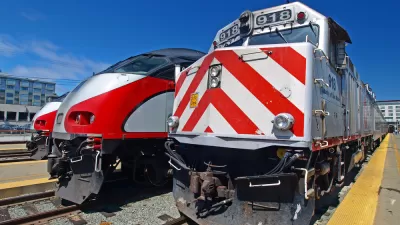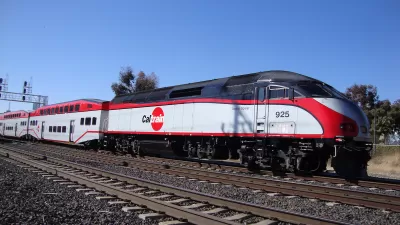At their July 7 meeting, the Caltrain Joint Powers Board, a 3-county body that administers the crowded San Jose-to-San Francisco commuter rail line, unanimously approved $1.25 billion in contracts to rail and infrastructure firms for electrification.

The 55-mile Caltrain commuter line runs 92 weekday trains connecting the three premier hubs of Silicon Valley: San Francisco, the Peninsula (home to Facebook in Menlo Park and Google in Mountain View), and San Jose. It has seen ridership escalate rapidly since it introduced its so-called 'baby bullet' trains in 2004. It's now ready to take the next big step: convert from diesel power to overhead electrification.
If, and that's a big 'if,' the funding falls into place, electric service could begin on 51 miles of the line in 2020. "The board’s unanimous vote highlighted its optimism in Caltrain’s ability to secure the remainder of its necessary funding," observed Samantha Weigel for the Daily Journal.
"Included in the contract is an order for 96 rail vehicles, with an option to buy an additional 20," reports Roger Rudick, Streetsblog SF editor.
According to the Caltrain staff report [PDF] issued during the meeting, the new electric multiple unit (EMU) trains will be built by Stadler, a Swiss company, and stringing the overhead wire and additional infrastructure for the electrification of the tracks will be done by the British firm Balfour Beatty.
Caltrain was the first railroad in the country to be granted a waiver by the Federal Railroad Administration (FRA) to use 'European-style' EMUs on tracks where diesel trains also operate. "For decades, the Federal Railroad Administration had effectively banned modern European trains from American mainline rail networks," according to Next City (posted here).
"What will it mean for commutes between San Francisco and the South Bay?" asks Ruddick.
In a previous post, Caltrain official Casey Fromson said because of the improved acceleration, a trip that diesel baby bullets do in 60 minutes will take 45 with a train of EMUs. Electric trains are also quieter, more reliable and non-polluting."
Funding not all in place
Electrification is one of two projects that compose the Caltrain Modernization Program.
“The total program is $2 billion. That includes money for the advanced signal system [aka positive train control] which we’re already installing today,” said Jayme Ackemann, spokeswoman for Caltrain. [See project status (PDF)]. “But the $1.25 billion is the lion’s share for electrification.”
"However, the regional local transit agency doesn’t yet have $1.3 billion in necessary funding — the gap includes contributions from high-speed rail as well as a federal grant it applied for last year that staff hopes to hear about by the year’s end," reports the Daily Journal's Weigel.
The agreements include provisions for both [Balfour Beatty and Stadler] to begin designing their projects with only a portion of funding, with acknowledgment they must wait until Caltrain secures the remainder before actually commencing construction.
Immediately following approval of the contracts, the board went on to enter into an agreement with the California High-Speed Rail Authority [PDF] for the state to provide a total of $713 million toward electrifying the corridor they may share. [See 2012 post on regional agreement to fund electrification].
However, not even the state funding is in place. Legislation introduced last month to distinguish funds for 'bookend projects,' including Caltrain electrification, from funds for the mainline construction which have yet to be authorized, is in the Senate Appropriations Committee.
Caltrain anticipates hearing whether its application for a $647 federal grant [for a Federal full funding grant agreement from the Federal Transit Administration] is approved later this year.
Weigel reports on opponents to the project, including the Town of Atherton in southern San Mateo County, "which alleges the environmental review of electrification is lacking and the impacts of bringing high-speed rail to the corridor would be overly burdensome."
The town, which had "the nation’s most expensive zip code" in 2014, and neighbor Menlo Park filed the first lawsuit against the High-Speed Rail Authority in 2009.
Caltrain, among the shortest lines in the country with only 77 miles including the Gilroy extension, had the seventh highest ridership among U.S. commuter rail lines last year. However, commute-hour trains are packed in both directions, resulting in it being the third highest ridership per mile, below only New York MTA's LIRR and Metro-North.
FULL STORY: It’s a Go for Caltrain Electrification

Alabama: Trump Terminates Settlements for Black Communities Harmed By Raw Sewage
Trump deemed the landmark civil rights agreement “illegal DEI and environmental justice policy.”

Study: Maui’s Plan to Convert Vacation Rentals to Long-Term Housing Could Cause Nearly $1 Billion Economic Loss
The plan would reduce visitor accommodation by 25% resulting in 1,900 jobs lost.

Why Should We Subsidize Public Transportation?
Many public transit agencies face financial stress due to rising costs, declining fare revenue, and declining subsidies. Transit advocates must provide a strong business case for increasing public transit funding.

Paris Bike Boom Leads to Steep Drop in Air Pollution
The French city’s air quality has improved dramatically in the past 20 years, coinciding with a growth in cycling.

Why Housing Costs More to Build in California Than in Texas
Hard costs like labor and materials combined with ‘soft’ costs such as permitting make building in the San Francisco Bay Area almost three times as costly as in Texas cities.

San Diego County Sees a Rise in Urban Coyotes
San Diego County experiences a rise in urban coyotes, as sightings become prevalent throughout its urban neighbourhoods and surrounding areas.
Urban Design for Planners 1: Software Tools
This six-course series explores essential urban design concepts using open source software and equips planners with the tools they need to participate fully in the urban design process.
Planning for Universal Design
Learn the tools for implementing Universal Design in planning regulations.
Smith Gee Studio
Alamo Area Metropolitan Planning Organization
City of Santa Clarita
Institute for Housing and Urban Development Studies (IHS)
City of Grandview
Harvard GSD Executive Education
Toledo-Lucas County Plan Commissions
Salt Lake City
NYU Wagner Graduate School of Public Service




























